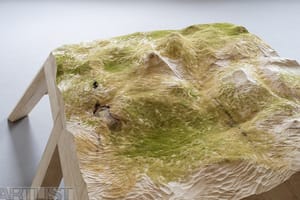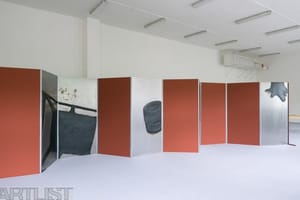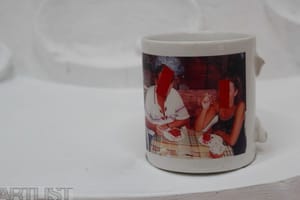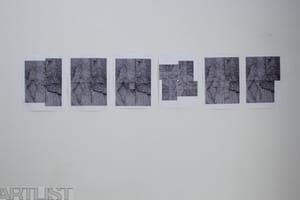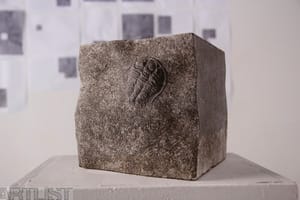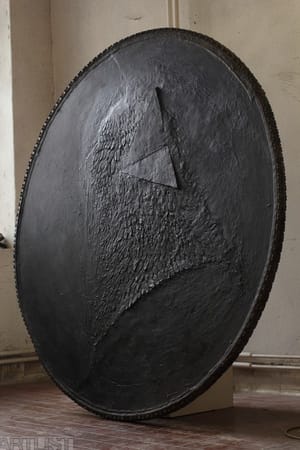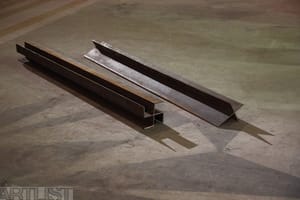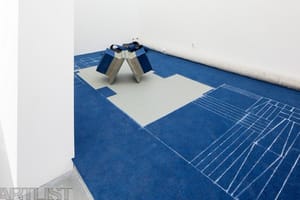- First Name
- Václav
- Surname
- Litvan
- Born
- 1983
- Birth place
- Český Krumlov
- Place of work
- Klučov
- Keywords
- CSU Library
- ↳ Find in the catalogue
About artist
Václav Litvan works less with the embodiment of concepts as with found materials, whose original properties he reacts to and develops further. He emphasises the availability and cheapness of the material he works with, after which there is the temporal characteristic of the material, its durability. He combines both traditional and modern industrial materials. His sculptural position is based on a view of concrete objects through drawing by which he materialises work with proportions, use of the relief, the unveiling and removal of layers, or the prosthetic addition of missing parts. He works with the tension between surface and material, with repetition and multiplication, with the roots of projected geometries and their conflict with the possibilities of materials and the boundaries of a specific item. In terms of shape he often deploys the tension between an applied object and a sculpture, but not on the level of real utilisation but more in terms of cultural artefacts.
In his installation for Karlin Studios (Na povrchu / On the Surface, 2017) he used torn out parquet formats from the refurbishment of the building where he lives. The underside, insulated with asphalt, again highlights his interest in surface, material and protrusion. However, On the Surface is the only example of Litvan using a readymade. In his other works he always develops a kind of logical form of the found object, e.g. in the installation for gallery 35m2 (Curved Memory, 2015).
The mug found in the garbage pin with the printed photo of a holiday couple becomes part of a larger object, both sculpture and relief, that works with the cylindrical shape and its curving effect on the plaster relief that adorns the embedded mug as though it were a still life. The motif from the second found mug, namely the lilac, Litvan straightened into a large asphalt object from which he physically exits. The cat as main subject of the print on the mug remains in the surface sculpture as a contour emerging from the profile (Still Life with Fauna and Flora, 2015). In the plasterboard globe hanging alongside Litvan stretches out the possibility of a spatial feeling in the surface: specifically the feeling of a bitten eighth again supplemented by a spatial object with teeth depicted in perspective.
In the installation for the Studio Hrdinů (with Ondřej Cibulka, Říše, 2014) he works with the found photograph of a dead leopard embracing its supposedly last victim. The photo is bent in an arc in the shape of two protractors (Klenba, idea, 2014) and has the effect of moving the leopard away from its victim. Litvan further develops this motif into an enlarged arched clay relief, a sculpture in which the repeated tableau becomes more abstract and its individual elements more distant visually from each other. The third element of this installation, a utopian realisation, is a construction, design, scaled model of the arc in which the subject became invisible to the eye. At the exhibition the elements were distributed in a vertical location from the highest point of the exhibition space (utopian model) to the lowest (idea – the protractor). The work thus comments on the methods of investigating and relating to the world in the sphere between touch, sight and measurement.
In Radar ve větru / Radar in the Wind (2009) Litvan integrates the connection of the fixed and unfixed, which then, in the form of semi-rigid, geometrically glued segments, he further develops in the installation On the Surface (2017) referred to above and in Bellows (2015), both of which comprise bulky metal parts lent a certain flexibility by harmonious adhesion. In Standing Lying (Gallery Kostka, 2014) this element is transformed into the motif of a carousel. In this work too he uses a found photograph, this time featuring a dead gorilla carried on a bamboo structure. The huge living material, the symbol of the way humans kill animals, is linked with a fairground attraction, the King-Kong carousel, and with the film character of the same name that is both monster and victim. The individual abstracted but not abstract motifs are further transformed and implemented within a purposeful sculptural installation. The work is further confirmation of Litvan’s interest in movement or dynamic, but frozen at the instant of matter.
This exists in certain performative moments in Litvan’s sculptures and is based on their specific attributes. In Big Brother is not Watching (2011) the concrete volume of the statue is so heavy that only its circular shape allows it to be rolled and thus manipulated. It is followed by the asphalt relief Black Head, Black Tail (2013), in which the movement is underscored by the outline of a mountain bike tyre, which deepens associations with a serrated coin while allowing the relief to be rolled more comfortably. The frozen movement is then repeated in more or less abstract motifs of fires (Barrier, 2013; Ready for Fire, 2012).
In his most recent works, Litvan further develops the encounter between the depicted and the figurative and the abstract and the geometrical. Shape lends meaning to the depiction, which it encounters in the material. This element of realism is significant for his sculptural position (exhibitions in Karlin Studios, Gallery 207 and Gallery Entrance).
- Author of the annotation
- Michal Novotný
- Published
- 2017
CV
Studium: 2007–2009 Monumentální tvorba – ateliér Jiřího Příhody 2005–2007 Socha I – ateliér Jaroslava Róny 2002–2005 Akademie výtvarného umění, Socha I - ateliér Jana Koblasy 1998–2002 SUPŠ Č. Krumlov, obor kamenosochařstí Stáže, tvůrčí pobyty:
2012 VIAFARINI-IN-RESIDENCE, Milano
Exhibitions
- Solo exhibitions
-
2017
NA POVRCH, Karlin Studios, Praha
LEHČÍ NEŽ VZDUCH, Galerie 207, Praha
2016
HUMANITA BEZ PRÁCE, INI Gallery, Praha
2015
ZAHNUTÁ VZPOMÍNKA , Galerie 35M2 , Praha
ZUBY NEBO ROHY, Galerie Entrance , Praha
2014
KINGDOM, Studio Hrdinů, Praha
STOJÍCÍ, LEŽÍCÍ Galerie Kostka, Praha
2013
SITUACE 32, Galerie Pavilon, Praha
BAZAR ANTIK ZÁNIK, Galerie KABINET Střítěž
2012
VIR OPEN STUDIO, Milano
2011
PŘÍPRAVA NA PŘÍPRAVU, s Patrikem Čablou, Galerie Entrance, Praha
2010
VLHKO NEBO ZÁZRAK, s Patrikem Čablou, Galerie Půda, Jihlava
2009
POLOOSTROV, s Annou Hulačovou, Galerie Jelení, Praha
JEDNA Z MOŽNOSTÍ EXISTENCIONÁLNÍ PODPORY ČLOVĚKA V LICHÉM DIMENZIONÁLNÍM PÁSMU, s Annou Hulačovou, Galerie NF, Ústí nad Labem
- Group exhibitions not included in ARTLIST.
-
2017
WITH WINGS, Pragovka Praha
2016
SEXY, Pragovka, Praha
2015
LITURGIE, České centrum, Paříž, Francie
2013
JEDNOHO DNE PŘIJDE DEN, KDY DEN NEPŘIJDE , FUTURA, Praha
LAPIDÁRIUM, Galerie Jaroslava Frágnera, Praha
2011
TRIAL (OUR HOUSE) / TRIAL TRAIL, Atelierhaus der Akademie der bildenden Künste Wien
62. UMĚLECKÝ SALON V POLIČCE
DIPLOMANTI AVU, Veletržní palác, Praha
2008
AVU 18, Veletržní palác, Praha
SOUČASNÝ ČESKÝ KUBISMUS, Staroměstská radnice, Praha
FORMA NÁSLEDUJE... RISK, Národní galerie Bratislava
2007
FORMA NÁSLEDUJE... RISK, Karlín studio, Praha




